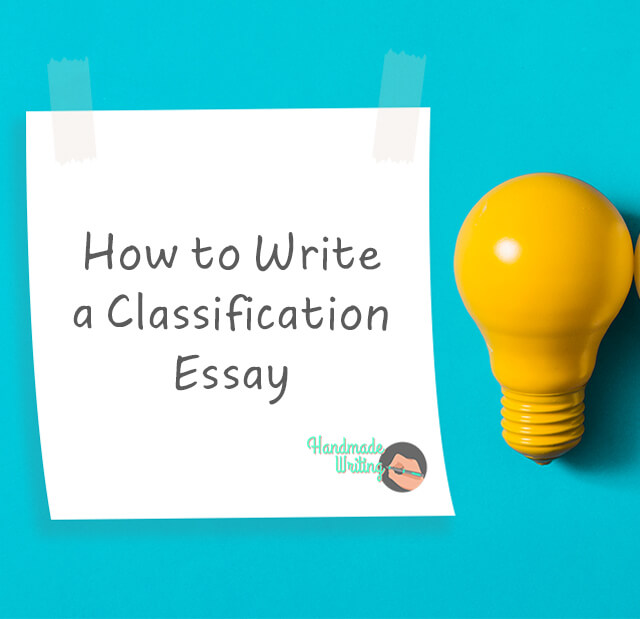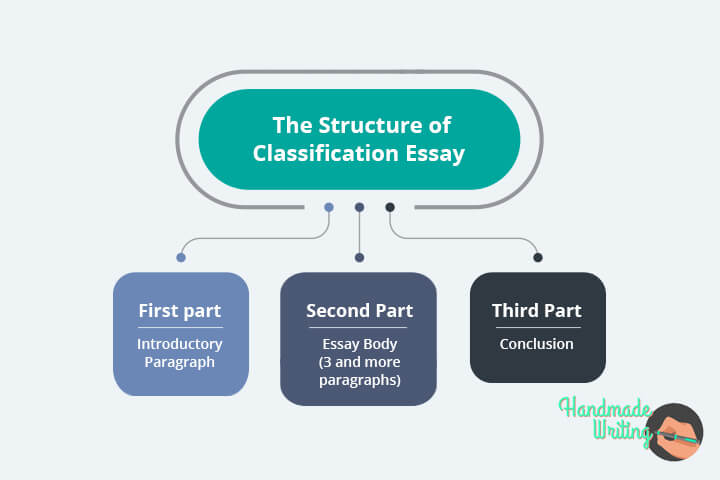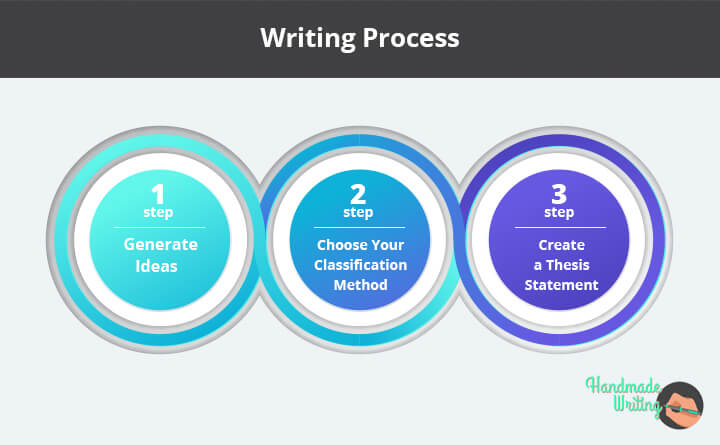How to Develop and Organize a Classification Essay
Basic Approaches to Drafting a Five-Paragraph Essay
- Writing Essays
- Writing Research Papers
- English Grammar
- Ph.D., Rhetoric and English, University of Georgia
- M.A., Modern English and American Literature, University of Leicester
- B.A., English, State University of New York
Classification is a method of developing an essay by arranging people, objects, or ideas with shared characteristics into particular classes or groups. After you have settled on a topic for a classification essay * and explored it through various prewriting strategies, you should be ready to attempt a first draft . Here is how to develop and organize a five-paragraph classification essay .

Introductory Paragraph
In your introduction , clearly identify your subject — in this case, the group you are classifying. If you have narrowed your subject in any way (for example, types of bad drivers, rock guitarists, or annoying moviegoers), make this clear from the start.
You may also want to provide some specific descriptive or informative details to attract the interest of your readers and suggest the purpose of the essay .
Finally, include a thesis sentence (usually at the end of the introduction) that briefly identifies the main types or approaches that you're about to examine.
Intro Paragraph Example: Baseball Fans
Here's an example of a short but effective introductory paragraph to a classification essay:
It's a warm evening in July, and all across the country Americans are gathering to watch a game of professional baseball. Armed with hot dogs and cold drinks, they stroll to their seats, some in grand stadiums, others in cozy minor-league parks. But no matter where the game is played, you will find the same three types of baseball fan: the Party Rooter, the Sunshine Supporter, and the Diehard Fan.
Notice how this introduction creates certain expectations. The specific details provide a setting (a ballpark on "a warm evening in July") in which we expect to see the various fans described. In addition, the labels assigned to these fans (the Party Rooter , the Sunshine Supporter , and the Diehard Fan ) lead us to expect descriptions of each type in the order they're given. A good writer will go on to fulfill these expectations in the body of the essay.
Body Paragraphs
Begin each body paragraph with a topic sentence that identifies a particular type of approach. Then illustrate each type with specific details.
Arrange your body paragraphs in whatever order strikes you as clear and logical — say, from the least effective approach to the most effective, or from the most common type to the least familiar (or the other way around). Just make sure that the order of your body paragraphs matches the arrangement promised in your thesis sentence.
Body Paragraphs Example: Types of Fans
Here, in the body of the essay on baseball fans, you can see that the writer has fulfilled the expectations set up in the introduction. (In each body paragraph, the topic sentence is in italics.)
The Party Rooter goes to games for the hot dogs, the gimmicks, the giveaways, and the companionship; he's not really that interested in the ballgame itself. The Party Rooter is the sort of fan who shows up on Buck-a-Brew Night, often with a gang of fellow partiers. He cracks jokes, hurls peanuts at the team mascot, applauds the exploding scoreboard, blasts an electronic horn whenever he pleases—and occasionally nudges a companion and asks, "Hey, who's winning?" The Party Rooter often wanders out of the park in the sixth or seventh inning to continue his celebrations in the car on the way home. The Sunshine Supporter, usually a more common type than the Party Rooter, goes to the park to cheer on a winning team and bask in its glory. When the home side is on a winning streak and still in contention for a playoff spot, the stadium will be packed with this sort of fan. As long as her team is winning, the Sunshine Supporter will be roaring at every play, waving her pennant and shouting out the names of her heroes. However, as the name implies, the Sunshine Supporter is a fickle fan, and her cheers quickly turn to boos when a hero strikes out or drops a line drive. She will stay around until the end of the game to celebrate a victory, but should her team fall a few runs behind, she's likely to slip out to the parking lot during the seventh-inning stretch. Diehard Fans are also strong supporters of the local team, but they go to the park to watch good baseball, not just to root for a winner. More attentive to the game than other fans, Diehards will study the stance of a power hitter, note the finesse of a quick fielder, and anticipate the strategy of a pitcher who has fallen behind in the count. While the Party Rooter is chugging a beer or dropping wisecracks, Diehards may be filling in a scorecard or commenting on a player's RBI tally over the past few months. And when a Sunshine Supporter boos an opposing player for tagging out a local hero, Diehards may be quietly applauding the expert moves of this "enemy" infielder. No matter what the score is, Diehard Fans remain in their seats until the last batter is out, and they may still be talking about the game long after it's over.
Comparisons Ensure Cohesion
Notice how the writer uses comparisons to ensure cohesion in the body of the essay. The topic sentence in both the second and third paragraphs refers to the preceding paragraph. Likewise, in the third body paragraph, the writer draws explicit contrasts between the Diehards and the other two types of baseball fans.
Such comparisons not only provide smooth transitions from one paragraph to the next but also reveal the sympathies of the writer. He begins with the type of fan he likes the least and ends with the one he most admires. We now expect the writer to justify his attitudes in the conclusion.
Concluding Paragraph
The concluding paragraph gives you an opportunity to draw together the various types and approaches you have been examining in the body of the essay. You may choose to offer a final brief comment on each one, summarizing its value or its limitations. Or you may want to recommend one approach over the others and explain why. In any case, make sure that your conclusion clearly emphasizes the purpose of your classification.
Concluding Paragraph: Only the Diehard Fans Remain
In the concluding paragraph to "Baseball Fans," consider whether the author has been successful in his effort to tie his observations together.
Professional baseball would have trouble surviving without all three types of fans. The Party Rooters provide much of the money that owners need to hire talented players. The Sunshine Supporters bring a stadium to life and help boost the morale of the home team. But only the Diehard Fans maintain their support all season long, year in and year out. By late September in most ballparks, enduring chilly winds, rain delays, and sometimes humiliating losses, only the Diehards remain.
Connecting the Conclusion to the Introduction
Notice how the writer hooks his conclusion back to the introduction by contrasting the chilly night in September with the warm evening in July. Connections such as this help to unify an essay and give it a sense of completeness.
As you develop and organize your draft , experiment with various strategies, but keep this basic format in mind: an introduction that identifies your subject and the different types of approaches; three (or more) body paragraphs that rely on specific details to describe or illustrate the types; and a conclusion that draws your points together and makes the overall purpose of the classification clear.
- Understanding General-to-Specific Order in Composition
- The Ultimate Guide to the 5-Paragraph Essay
- How To Write an Essay
- What Is Expository Writing?
- Definition and Examples of Body Paragraphs in Composition
- Understanding Organization in Composition and Speech
- How to Structure an Essay
- How to Write and Format an MBA Essay
- How to Write a Narrative Essay or Speech
- 3 Changes That Will Take Your Essay From Good To Great
- Examples of Great Introductory Paragraphs
- How to Write a Great Essay for the TOEFL or TOEIC
- How to Write Your Graduate School Admissions Essay
- What an Essay Is and How to Write One
- 6 Steps to Writing the Perfect Personal Essay
- How to Teach Topic Sentences Using Models
How to Write a Classification Essay?
17 July, 2020
8 minutes read
Author: Elizabeth Brown
Classification essay is comparable to painting creation - an artist works on a specific structure that holds the picture’s elements together and glues different layers to create a powerful visual effect. The same principle applies to a writing piece, in which the central role is devoted to getting things in order. In this article, we’ll discuss the main features and components of a great classification essay and share some tips and tricks on how to take your piece of writing to the next level.

Classification essay definition
We bet the first thing you want to know concerning the topic is what is a classification essay? This is the task which you’ll most likely deal with at some point in your student life. The essence of this assignment is related to categorization and generalization. Remember these two words because they form the true meaning of classification essay. Also, division and classification are those elements of this essay type which highly correlate and have equal importance for essay creation. Therefore, the main task here is to organize or sort things into categories.


How to write a classification essay
Careful attention to planning marks the indication of quality in terms of classification essay. At this point, the main task is to learn how to structure the paper. The length of an article may vary, but the most frequently used “five paragraphs” method is typically applied for classification writing. What does this structure suggest? It has to do with a logical division of your essay into blocks and categories, every one of which should clarify a particular issue.
The first and one of the essential paragraphs is the introductory one. It’s an opening which illuminates the matter you’re going to discuss and the subject you’ll categorize. Besides, you can outline the purpose of your classification essay to readers to bring more clarity into the discussion. Answer the question of why you are categorizing the chosen items and what criteria you use for each of them. Then, you’ll need to close the introduction paragraph with a thesis. It will briefly sum up the objective of your classification and division essay, and identify the categories which you’ll be using for a paper.
The second part is the essay body. Here, a couple of paragraphs are applicable, preferably 3 and more. The most critical nuance you should remember while composing a body is that each paragraph will deal with a separate category. The best way to organize the central part of your division essay is to explain the criteria for each category and desirably, discuss strengths and weaknesses. More importantly, you should include examples that’ll back up your statements with a piece of evidence. Notably, there should be an equal amount of examples for every category to spread the evidence evenly. If your paragraphs in the main body are lengthy, you can also divide them into shorter ones to create a smooth transition between the blocks of text and improve readability.
The final paragraph of your classification essay is a conclusion. The closing statements will sum up the different categories highlighted in the body. Also, it’s advisable to restate each category and advise readers on the subject matter. However, if you choose to recommend this or that topic over the others, don’t forget to state the reason for your stance. This way, readers will take into account your well-grounded explanation, which is deprived of subjectivity, and make relevant conclusions for themselves.

Apart from the basic understanding of classification essay structure , you should also get prepared for the writing process. For many, implementing theory on practice is even more challenging than the stage of composing an essay. Nonetheless, with enough patience and endurance, this process is really not so bad after all. So, what steps do you need to make in order to prepare well for classification paper writing?
First things first, planning is everything when it comes to the assignment that implies classification. Without a clear and coherent plan, there’s no way you can write a good paper. Therefore, make sure that you have a robust scheme before writing your essay. For this, proceed with the following planning steps:
- Generate Ideas. Evidently, your essay won’t write itself. If your professor has not assigned you a specific topic, it’s time to do some brainstorming. Remember – you need to choose a group of people, things, or ideas that can be easily divided into categories and then compared.
- Choose Your Classification Method. Aim at one principle for classification for each category you describe. For example, if you write about people, you can categorize them by age, gender, appearance, or other factors. This will help you better structure your essay and make it look more organized in the eyes of readers.
- Create a Thesis Statement. As previously mentioned, the thesis statement is the element which closes the introduction of your classification essay. It should include such information as the subject matter, the categories, and the criteria used to classify each category. Besides, you can note down the purpose of your division into these categories.

Classification essay outline
The outline is a general description or plan that schematically displays the main points of your essay. The main point of an outline is to help you see the structure of your essay and use it as a useful guide for writing. Usually, a typical outline describes the essence of each point in one sentence. Also, bullet points are not uncommon, so you can use them to arrange a plan the way you feel is the most appropriate.
Classification essay topics
There is a plethora of themes and subjects for division classification essays to choose from, but most of them are hard to think of straight away. That’s why we’ve collected the list of the top used classification topics for you to facilitate the process of generating ideas or searching for ones elsewhere.
- The most popular devices students use nowadays
- Colors and their meaning in the paintings of Frida Kahlo
- The evolution of rock-music types
- Standard methods students use to prepare for exams
- Public speakers that have moved the world
- Unique factors to determine a successful relationship
- How to improve child-parent relationships
- Main motives to start a political career
- Learning techniques for college students
- Types of TV comedy shows
- Traveling destinations
- The main types of mobile applications
- Communication possibilities online
- Strategies for making decisions in business
- Leadership and leader types
- Conflicts at the job and ways to cope with them
- The motivation for doing sports
- Methods to reduce stress
No matter which theme you choose for your classification essay and what techniques you implement to make them elaborated, remember always to keep the structure in mind. The first step to writing this type of assignment is not just sitting and jotting down detached ideas, but planning out clear statements which can later be transmitted on paper. Hopefully, our advice will help you on the way to writing an excellent classification essay which your professor will mark with an A+ grade.
Problems with writing Your Classification Essay? Try our Online Essay Writer Service!

A life lesson in Romeo and Juliet taught by death
Due to human nature, we draw conclusions only when life gives us a lesson since the experience of others is not so effective and powerful. Therefore, when analyzing and sorting out common problems we face, we may trace a parallel with well-known book characters or real historical figures. Moreover, we often compare our situations with […]

Ethical Research Paper Topics
Writing a research paper on ethics is not an easy task, especially if you do not possess excellent writing skills and do not like to contemplate controversial questions. But an ethics course is obligatory in all higher education institutions, and students have to look for a way out and be creative. When you find an […]

Art Research Paper Topics
Students obtaining degrees in fine art and art & design programs most commonly need to write a paper on art topics. However, this subject is becoming more popular in educational institutions for expanding students’ horizons. Thus, both groups of receivers of education: those who are into arts and those who only get acquainted with art […]

Want to create or adapt books like this? Learn more about how Pressbooks supports open publishing practices.
10.4 Classification
Learning objectives.
- Determine the purpose and structure of the classification essay.
- Understand how to write a classification essay.
The Purpose of Classification in Writing
The purpose of classification is to break down broad subjects into smaller, more manageable, more specific parts. We classify things in our daily lives all the time, often without even thinking about it. Cell phones, for example, have now become part of a broad category. They can be classified as feature phones, media phones, and smartphones.
Smaller categories, and the way in which these categories are created, help us make sense of the world. Keep both of these elements in mind when writing a classification essay.
Choose topics that you know well when writing classification essays. The more you know about a topic, the more you can break it into smaller, more interesting parts. Adding interest and insight will enhance your classification essays.
On a separate sheet of paper, break the following categories into smaller classifications.
- The United States
- Colleges and universities
The Structure of a Classification Essay
The classification essay opens with an introductory paragraph that introduces the broader topic. The thesis should then explain how that topic is divided into subgroups and why. Take the following introductory paragraph, for example:
When people think of New York, they often think of only New York City. But New York is actually a diverse state with a full range of activities to do, sights to see, and cultures to explore. In order to better understand the diversity of New York state, it is helpful to break it into these five separate regions: Long Island, New York City, Western New York, Central New York, and Northern New York.
The underlined thesis explains not only the category and subcategory but also the rationale for breaking it into those categories. Through this classification essay, the writer hopes to show his or her readers a different way of considering the state.
Each body paragraph of a classification essay is dedicated to fully illustrating each of the subcategories. In the previous example, then, each region of New York would have its own paragraph.
The conclusion should bring all the categories and subcategories back together again to show the reader the big picture. In the previous example, the conclusion might explain how the various sights and activities of each region of New York add to its diversity and complexity.
To avoid settling for an overly simplistic classification, make sure you break down any given topic at least three different ways. This will help you think outside the box and perhaps even learn something entirely new about a subject.
Using your classifications from Note 10.43 “Exercise 1” , write a brief paragraph explaining why you chose to organize each main category in the way that you did.
Writing a Classification Essay
Start with an engaging opening that will adequately introduce the general topic that you will be dividing into smaller subcategories. Your thesis should come at the end of your introduction. It should include the topic, your subtopics, and the reason you are choosing to break down the topic in the way that you are. Use the following classification thesis equation:
topic + subtopics + rationale for the subtopics = thesis.
The organizing strategy of a classification essay is dictated by the initial topic and the subsequent subtopics. Each body paragraph is dedicated to fully illustrating each of the subtopics. In a way, coming up with a strong topic pays double rewards in a classification essay. Not only do you have a good topic, but you also have a solid organizational structure within which to write.
Be sure you use strong details and explanations for each subcategory paragraph that help explain and support your thesis. Also, be sure to give examples to illustrate your points. Finally, write a conclusion that links all the subgroups together again. The conclusion should successfully wrap up your essay by connecting it to your topic initially discussed in the introduction. See Chapter 15 “Readings: Examples of Essays” to read a sample classification essay.
Building on Note 10.43 “Exercise 1” and Note 10.46 “Exercise 2” , write a five-paragraph classification essay about one of the four original topics. In your thesis, make sure to include the topic, subtopics, and rationale for your breakdown. And make sure that your essay is organized into paragraphs that each describes a subtopic.
Key Takeaways
- The purpose of classification is to break a subject into smaller, more manageable, more specific parts.
- Smaller subcategories help us make sense of the world, and the way in which these subcategories are created also helps us make sense of the world.
- A classification essay is organized by its subcategories.
Writing for Success Copyright © 2015 by University of Minnesota is licensed under a Creative Commons Attribution-NonCommercial-ShareAlike 4.0 International License , except where otherwise noted.

IMAGES
VIDEO
COMMENTS
Updated on July 03, 2019. Classification is a method of developing an essay by arranging people, objects, or ideas with shared characteristics into particular classes or groups. After you have settled on a topic for a classification essay * and explored it through various prewriting strategies, you should be ready to attempt a first draft.
Classification essay outline. The outline is a general description or plan that schematically displays the main points of your essay. The main point of an outline is to help you see the structure of your essay and use it as a useful guide for writing. Usually, a typical outline describes the essence of each point in one sentence.
Exercise 3. Building on Note 10.43 “Exercise 1” and Note 10.46 “Exercise 2”, write a five-paragraph classification essay about one of the four original topics. In your thesis, make sure to include the topic, subtopics, and rationale for your breakdown. And make sure that your essay is organized into paragraphs that each describes a ...